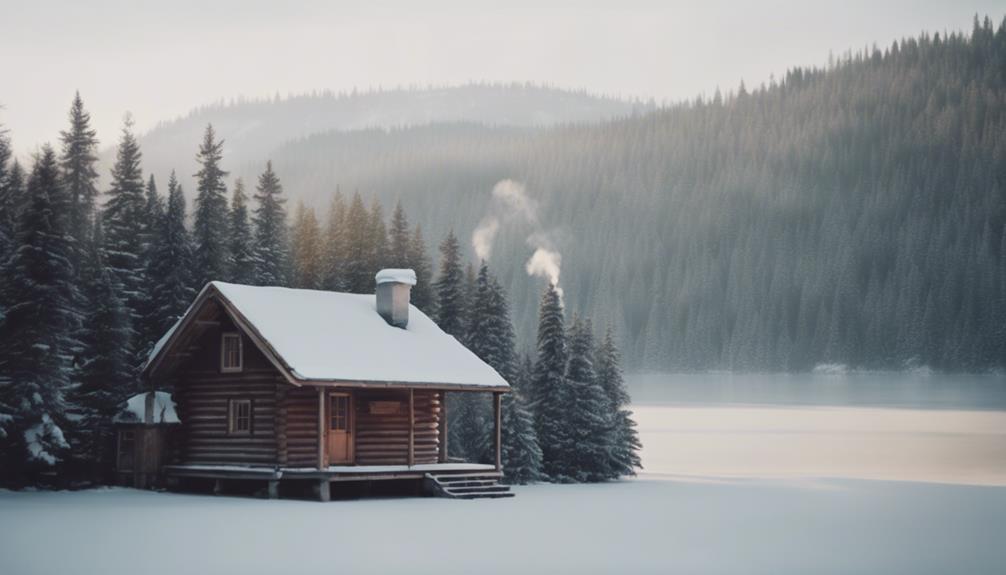In winter, you can forage resilient wild greens like chickweed, watercress, and daisy greens, especially during warm snaps or snow melts. You’ll find edible roots such as Jerusalem artichoke, burdock, and wild garlic still underground, and lichens like Usnea are accessible after storms. Nuts like acorns and black walnuts, along with berries like highbush cranberries and wintergreen, remain available. You can also tap trees for sap or harvest mushrooms like Chaga and turkey tail. Keep learning to identify and harvest sustainably.
Key Takeaways
- Wild greens like chickweed, watercress, and daisy greens can be foraged during warm spells or snow melts in winter.
- Nuts, acorns, and tree fruits such as crabapples and wild grapes are harvestable and store well through winter.
- Tree sap from maple, birch, and tamarack can be tapped during winter for sweet beverages.
- Inner bark of pine and birch is edible and sustainable to harvest for nutrition and medicinal uses.
- Mushrooms like Chaga and turkey tail grow year-round, with winter offering easier access and potent medicinal qualities.
Resilient Wild Greens and Roots

Have you ever wondered which wild greens and roots you can safely harvest during winter? During winter foraging, many wild greens like chickweed, claytonia, watercress, and daisy greens stay resilient and can be harvested during warm spells or when snow melts. Edible roots such as Jerusalem artichoke, burdock, and evening primrose remain underground, identifiable by dried tops protruding through the snow. Early spring greens like chickweed, wild onion, and marsh marigold often sprout now, providing essential nutrients. You can safely harvest roots like Jerusalem artichokes and wild garlic if you’re familiar with their patches. Avoid out-of-season roots such as Queen Anne’s Lace, which are not suitable for winter foraging. Wild lichens, including Usnea, are also edible and often dislodge after storms, making them accessible during winter.
Nut and Seed Harvesting in Winter

Winter is an excellent time to gather nuts and seeds, as many tree species still hold their provisions through the cold months. You can find black walnuts, acorns, and other wild edibles ready for harvest. Here are some tips to maximize your foraging:
- Black walnuts: Quickly remove green husks to prevent bitterness, then crack tough shells with a hammer or heavy rock. Utilizing proper tools can make shelling more efficient and protect your hands. Incorporating techniques for safely opening shells ensures a more enjoyable experience. Additionally, knowing best tools for shelling can streamline the process and reduce effort. Using the right shelling techniques can also help preserve the nut meats better.
- Acorns: Collect fallen acorns under oak trees and leach tannins using cold water before turning them into flour. Understanding content creation can help you document your foraging adventures and share tips with others.
- Timing and location: Harvest early before squirrels and rodents strip the trees, or find areas with less rodent activity for better yields. Additionally, understanding sound vibrations can enhance your sensory awareness during outdoor exploration, making foraging more mindful and enjoyable.
Tree Fruits That Persist Through Cold

Many tree fruits remain accessible and usable throughout the cold months, making them valuable for winter foraging. Crabapples, for example, often improve in flavor after winter cold and can last on the tree into early spring. They’re reliable and can be used for jellies or fermented into mild alcoholic beverages. Some apple varieties store for up to a year, and their slight fermentation during cold snaps adds flavor. Wild grapes also persist, often freeze-drying on the vine, providing natural dried fruit that’s easy to harvest in winter. Additionally, winter fruits like highbush cranberries stay on their bushes, offering tart berries for jelly, syrup, or raw eating. Harvesting these fruits at their peak can enhance their nutritional value, especially when consumed fresh or preserved properly. These hardy fruits ensure you have nutritious options even when temperatures drop. Incorporating seasonal foraging into your routine can help you discover even more local, resilient foods during the winter months. To maximize your harvest, understanding fruit preservation techniques can help you enjoy these seasonal treats longer. For example, using proper storage methods can extend the usability of these fruits well into the colder months. Properly managing your foraged foods can also reduce waste and promote sustainable practices in your winter gathering efforts.
Winter Berries and Small Fruits

Winter berries and small fruits offer reliable, tasty options when other forage is scarce. Many stay on plants beneath snow or in sheltered spots, providing tart, nutritious snacks. Collecting these fruits can boost your energy and flavor your winter meals. Using proper identification techniques can help ensure safety and avoid toxic varieties. Being aware of plant distribution can also aid in finding the best foraging locations during cold months. Additionally, understanding plant resilience can help you locate plants that are more likely to bear fruit in winter conditions. Recognizing frost tolerance in certain plants can further improve your chances of successful foraging in winter.
Persistent Fruit Options
Certain berries and small fruits remain accessible well into late winter, providing valuable foraging opportunities when other food sources are scarce. These persistent wild berries can be a vital nutrition source during cold months.
- Teaberries (wintergreen): These highly nutritious berries stay on their plants into late winter, offering vitamin C-rich snacks you can eat raw, make into jams, or brew into teas.
- Partridgeberries: Remaining on their vines, these small, red berries are available even when snow covers the ground, perfect for harvesting without damaging the plants.
- Highbush cranberries and nannyberries: Often frozen on the vine, they can be dug out or harvested directly, providing a reliable winter food source.
- Color accuracy in display affects how true-to-life these berries appear, which can influence your identification and harvesting success.
- Recognizing these wild, winter-sturdy berries helps you maximize foraging during the cold months. Color accuracy plays a key role in ensuring you accurately identify edible berries versus inedible ones.
Tasty, Tart, and Nutritious
As you explore the winter landscape, you’ll discover a variety of berries and small fruits that remain ripe and flavorful despite the cold. Winter berries like crabapples, rosehips, and hawthorn berries offer a tart, vitamin-packed boost, perfect for wild foods during the off-season. Wild grapes cling to vine-covered trees, often drying into natural raisins after freeze-thaw cycles. Teaberries (wintergreen) and partridge berries stay fresh beneath the snow, ready to be dug up in late winter or early spring. Highbush cranberries persist on bushes, providing tart berries that can be cooked into jams or added to mulled cider. Many small fruits are preserved in dried or frozen forms, making them valuable sources of nutrients throughout the winter months. Incorporating wild edibles from these wild sources can support your health during the colder months. Additionally, understanding signs of spoilage helps ensure that your gathered berries remain safe and nutritious to enjoy.
Edible Tree Sap and Inner Bark

You can tap into trees like maple, tamarack, and birch for their sweet sap during winter, but it’s important to use proper techniques to guarantee the tree stays healthy. The inner bark of trees such as pine and birch offers a nutritious food source that you can harvest carefully to ascertain the tree stays healthy. Understanding how to collect sap and inner bark responsibly lets you enjoy these natural resources safely and sustainably. Additionally, being aware of renewable energy sources can inspire outdoor adventures that complement your foraging experiences. Incorporating local investment options into your planning can also support sustainable practices and community resilience. Utilizing diverse gardening materials can further enhance your outdoor environment and promote eco-friendly harvesting methods.
Sap Harvesting Techniques
During winter foraging, tapping trees for sap and harvesting inner bark are efficient ways to gather essential nutrients. To effectively harvest sap, follow these steps:
- Drill a shallow hole into the tree trunk during late winter when sap flow peaks.
- Insert a spile or tube to direct sap into a container, ensuring it’s emptied regularly to prevent spoilage.
- Collect the sap consistently, avoiding over-tapping to protect the tree’s health.
For inner bark, carefully peel layers from the tree trunk, removing only what’s needed without causing significant damage. This minimal impact encourages future growth. Both methods rely on understanding seasonal timing—late winter offers the strongest sap flow. Using these techniques, you can sustainably gather crucial nutrients while respecting the health of the trees.
Uses of Inner Bark
Inner bark from trees like birch and pine serves as a essential edible resource during winter, providing essential nutrients when other food sources are scarce. During winter foraging, harvesting inner bark offers a reliable way to supplement your diet. You can dry and grind the inner bark into nutritious flour with a mild flavor similar to buckwheat, making it versatile for cooking. Birch bark contains sugars and nutrients that can be brewed into teas or cooked for sustenance. Pine bark, especially from young trees, can be stripped, cooked, and used for flavor or medicinal purposes. Remember to harvest sustainably by taking small, radial strips from mature trees, ensuring their health remains intact. Inner bark remains a critical edible resource during winter, supporting survival and nourishment. Utilizing automation in data analysis can further enhance the processing and understanding of nutrient content in wild foraged foods.
Mushroom Foraging: Chaga and Turkey Tail

Have you ever wondered why winter is the best time to forage for Chaga and turkey tail mushrooms? During this season, these fungi are easier to find and harvest at their peak potency. Here are three reasons to focus on winter foraging:
- Chaga’s hard, dormant state makes it easier to harvest without damaging the host birch tree, and its medicinal properties are most concentrated.
- Turkey tail mushrooms are abundant and easy to identify with their vibrant, fan-shaped caps, making them a popular winter target.
- Both fungi grow year-round, but winter collection ensures better access and potency, especially for brewing immune-boosting teas or tinctures.
Focusing on foraging during winter helps you gather high-quality Chaga and turkey tail efficiently and sustainably.
Recognizing and Foraging Other Winter Plants

Even in the depths of winter, many hardy plants and natural resources remain accessible if you know where to look. You can find greens like chickweed, watercress, and daisy greens emerging through snow or leaf litter during warm spells. These plants often show subtle signs beneath the snow or in thawed soil, making them easier to identify with careful observation. Edible roots such as burdock, wild carrot, and evening primrose stay underground but can be located by following dried plant remains or protruding tops. Additionally, wild lichen like Usnea can be harvested after storms dislodge them from trees. Recognizing these plants and roots expands your winter foraging options, providing nutritious wild foods even when the air is cold.
Early Spring Foraging Opportunities

As winter recedes and snow begins to melt, new foraging opportunities emerge in early spring. Beneath the thawed soil, you can harvest Jerusalem artichokes—tubers that store nutrients from winter’s end. Look for early spring greens like chickweed, watercress, and claytonia, which often sprout even under snow cover or mild thaw conditions. Wild herbs such as wild onions and evening primrose also appear, providing essential nutrients after months of scarcity.
Here are some key early spring foraging options:
Discover early spring foraging: Jerusalem artichokes, greens, and wild herbs emerging from winter’s grip.
- Jerusalem artichokes hidden underground
- Tender early spring greens emerging amidst snow cover
- Wild herbs like onions and primrose surfacing first
Recognizing these signs allows you to safely gather nutritious foods as the seasons change.
Tips for Safe and Sustainable Winter Foraging

To forage safely and sustainably during winter, it’s essential to know how to identify wild plants and fungi before harvesting. Pay close attention to seasonal cues and visual signs unique to winter, such as leafless branches or dormant fungi. Use proper tools like shears or small rakes to avoid damaging trees and plants, and harvest only what you need to protect ecosystems. Be cautious around water sources; verify shellfish, seaweed, and freshwater plants are safe to eat by checking for pollution and correct identification. Dress in layered, insulated clothing, and carry safety gear to prevent cold injuries. Remember, winter foraging requires respect for nature’s limits and careful planning.
| Key Tips | Focus Area | Why It Matters |
|---|---|---|
| Know seasonal cues | Identifying winter plants | Prevents misidentification |
| Use proper tools | Harvesting techniques | Protects ecosystems |
| Respect water sources | Safety & sustainability | Ensures food safety |
Frequently Asked Questions
Can You Forage in the Winter?
Yes, you can forage in winter. You just need to know what’s available, like nuts, seeds, and persistent fruits such as crabapples and rosehips. Mushrooms like chaga and turkey tail are also harvestable year-round with proper identification. Look for plant remains protruding from snow or soil, and use tools to uncover hidden edibles. Winter foraging requires careful observation, but you’ll find plenty to gather even in cold weather.
What Is the 1 3 Rule for Foraging?
The 1-3 Rule for foraging helps guarantee you’re harvesting responsibly. You should only gather plants or mushrooms when you’re confident in their identification and only take up to one-third of what’s available. This approach prevents overharvesting, protects the environment, and allows the resources to regenerate. Always be cautious, accurate, and respectful of nature, so you can enjoy sustainable foraging and preserve wild food sources for future use.
Are There Edible Plants That Grow in Winter?
You’re wondering if edible plants grow in winter. Yes, many do, especially in milder climates or under snow cover. You can find chickweed, watercress, and dandelion greens thriving during winter. Trees like birch and pine offer edible bark and inner bark, while berries such as holly, juniper, and rose hips remain on bushes. Roots like Jerusalem artichokes are accessible underground, and fungi like chaga and turkey tail grow on trees, providing additional foraging options.
How to Get Food in the Winter?
Like a navigator seeking hidden treasures, you can find winter food by foraging smartly. Look for persistent wild fruits like crabapples and rosehips on trees, dig up roots such as burdock and wild carrots beneath the snow, and gather nuts like acorns and beechnuts, processing them before eating. Don’t forget to harvest medicinal mushrooms like chaga and turkey tail on trees, or collect pine nuts and resin from evergreens for nutrition and practical uses.
Conclusion
Winter foraging might seem limited, but with a keen eye, you can uncover hidden treasures like resilient greens, hearty roots, and unique mushrooms. Some say foraging in winter boosts your immune system and deepens your connection to nature. While evidence varies, embracing winter foraging encourages sustainability and self-reliance. So bundle up, stay curious, and explore the cold—your next wild feast could be just beyond the snow.










